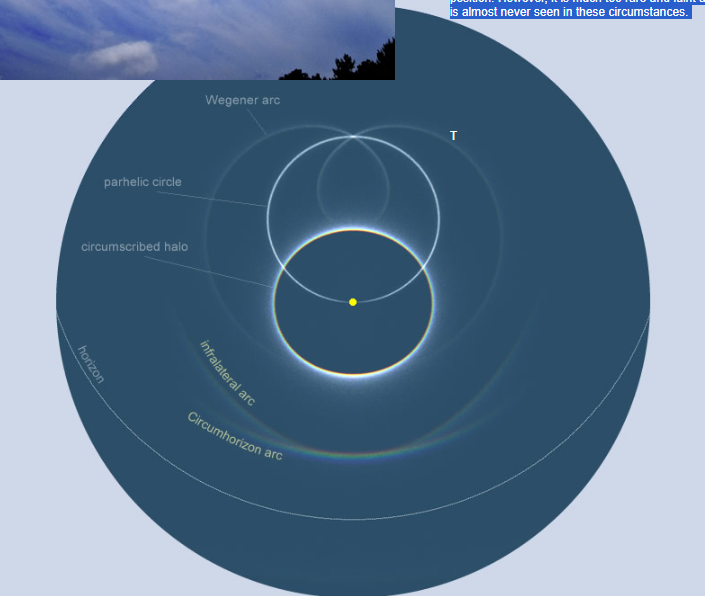CHA or Infralateral
CHA or Infralateral: Understanding the Difference
Have you ever looked up at the sky and been captivated by the beautiful optical phenomena that occur? One such phenomenon is the circumhorizon arc (CHA) and its close counterpart, the infralateral arc. These arcs are created by the interaction of sunlight with ice crystals in the atmosphere, resulting in stunning displays of color and light. While they may appear similar at first glance, there are subtle differences between the two that can be observed under certain conditions.
The circumhorizon arc is an immense and colorful arc that forms when plate-oriented ice crystals interact with sunlight. It is typically seen when the sun is high in the sky and stretches partially around the horizon at a constant altitude. This arc is parallel to the horizon and can be easily distinguished by its vibrant hues and expansive shape. Its position remains fixed, regardless of the observer's location, making it a truly awe-inspiring sight.
On the other hand, the infralateral arc is produced by sunlight passing between the side and end faces of column crystals. Similar to the circumhorizon arc, it is visible when the sun is high in the sky. The infralateral arc occupies almost the same position in the sky as the circumhorizon arc, making it challenging to differentiate between the two, especially in photographs where only a fragment of the arcs is visible.
In some rare instances, both the circumhorizon arc and the infralateral arc can be observed simultaneously, creating a truly remarkable spectacle. When both arcs are present, it becomes easier to distinguish them. The upper arc is the infralateral arc, which can be identified by its slight upward climb in the sky at its ends. This distinguishes it from the circumhorizon arc, which remains parallel to the horizon.
It's worth noting that the 46° circular halo, another atmospheric optical phenomenon, would also occupy a similar position in the sky. However, this halo is much rarer and fainter compared to the CHA and infralateral arc, making it almost never seen under these circumstances. The presence of both arcs adds an extra layer of complexity and beauty to the atmospheric display, leaving observers in awe of the wonders of nature.
To fully appreciate the magnificence of the CHA and infralateral arc, it's important to experience them firsthand. Photographs may not always capture the true essence of these phenomena, as they often show only a fragment of the arcs. In-person observation allows for a more comprehensive understanding of their size, shape, and vibrant colors.
In conclusion, while the circumhorizon arc and infralateral arc may appear similar at first glance, there are subtle differences that set them apart. Understanding these differences enhances our appreciation for the intricate interplay between sunlight and ice crystals in the atmosphere. So, next time you find yourself gazing at the sky on a sunny day, keep an eye out for these mesmerizing arcs and let yourself be captivated by their beauty.

Circumhorizon and Infralateral Arc captured by Bryce Bradford (more images). �Bryce Bradford, shown with permission.
The immense and colourful circumhorizon arc made by plate oriented ice crystals is seen when the sun is high. It stretches from beneath the sun partially around the horizon and always at the same altitude.
The infralateral arc produced by sunlight passing between the side and end faces of column crystals occupies almost the same position in the sky when the sun is high.
It is very difficult to tell the arcs apart in a photograph especially when only a fragment is visible.
Here - unusually - both arcs are present. The upper arc is the infralateral. Unlike the circumhorizon arc, it is not parallel to the horizon but climbs slightly higher in the sky at its ends.
The 46° circular halo would also occupy a similar position. However, it is much too rare and faint and is almost never seen in these circumstances.

Note: this article has been automatically converted from the old site and may not appear as intended. You can find the original article here.
Reference Atmospheric Optics
If you use any of the definitions, information, or data presented on Atmospheric Optics, please copy the link or reference below to properly credit us as the reference source. Thank you!
-
<a href="https://atoptics.co.uk/blog/cha-or-infralateral/">CHA or Infralateral</a>
-
"CHA or Infralateral". Atmospheric Optics. Accessed on November 26, 2024. https://atoptics.co.uk/blog/cha-or-infralateral/.
-
"CHA or Infralateral". Atmospheric Optics, https://atoptics.co.uk/blog/cha-or-infralateral/. Accessed 26 November, 2024
-
CHA or Infralateral. Atmospheric Optics. Retrieved from https://atoptics.co.uk/blog/cha-or-infralateral/.